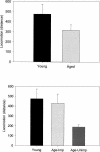Effect of age and level of cognitive function on spontaneous and exploratory behaviors in the beagle dog
- PMID: 11773431
- PMCID: PMC311391
- DOI: 10.1101/lm.41701
Effect of age and level of cognitive function on spontaneous and exploratory behaviors in the beagle dog
Abstract
Cognitively characterized young and aged beagle dogs were administered six different spontaneous behavior tests, which provided measures of locomotion, exploration, and social interaction. Consistent with our previous findings, we obtained no overall effect of age on locomotion. We did find, however, that for the aged dogs locomotion correlated with level of cognitive function, being lowest in age-unimpaired dogs and highest in impaired dogs. Exploratory behavior, as measured by response to novelty, varied with age, with young dogs scoring the highest. Young dogs spent more time with novel toys and a person, responded more to a silhouette of a dog, and interacted more with a model dog compared to aged dogs. Among the aged dogs, age-unimpaired dogs spent the greatest amount of time sitting or standing beside a person whereas age-impaired dogs spent the most time reacting to a reflection in a mirror. The age-impaired dogs show undirected, stereotypical types of behavioral patterns. These differences in activity patterns may be linked to underlying age-associated neuropathology.
Figures





References
-
- Adams B, Chan A, Callahan H, Milgram NW. The canine as a model of human cognitive aging: Recent developments. Prog Neuropsychopharmacol Biol Psychiatry. 2000b;24:675–692. - PubMed
-
- Adams B, Chan A, Callahan H, Siwak C, Tapp D, Ikeda-Douglas C, Atkinson P, Head E, Cotman CW, Milgram NW. Use of a delayed non-matching to position task to model age-dependent cognitive decline in the dog. Behav Brain Res. 2000a;108:47–56. - PubMed
-
- Archer J, Birke LIA. Exploration in animals and humans. Great Britain: Van Nostrand Reinhold (UK); 1983. Methods of studying exploration; pp. 27–39.
-
- Berlyne DE. Novelty and curiosity as determinants of exploratory behavior. Br J Psychol. 1950;41:68–80.
-
- Berlyne DE. The arousal and satiation of perceptual curiosity in the rat. J Comp Physiol Psychol. 1955;48:238–246. - PubMed
Publication types
MeSH terms
Grants and funding
LinkOut - more resources
Full Text Sources
Other Literature Sources
Medical
